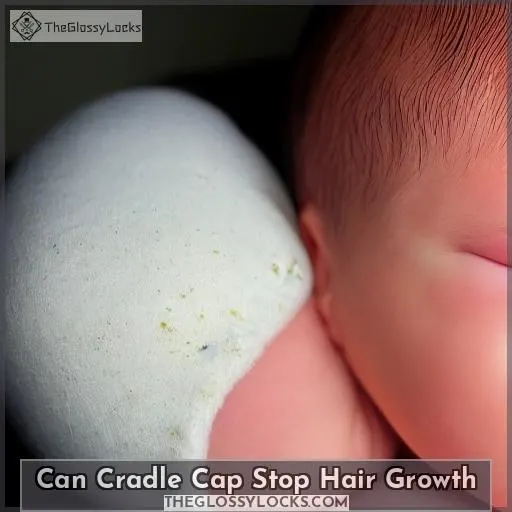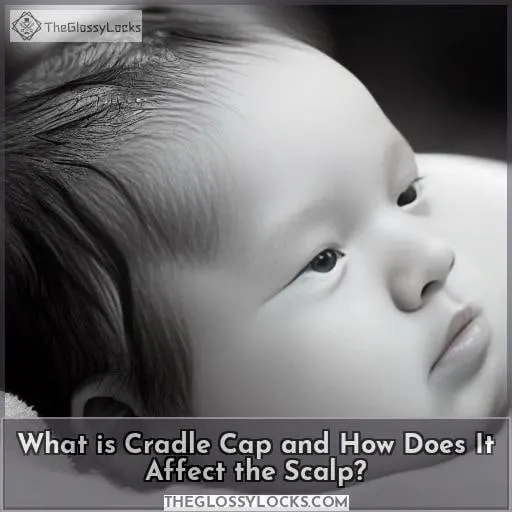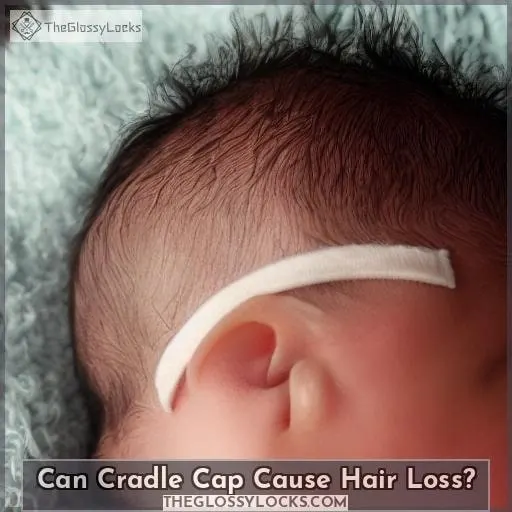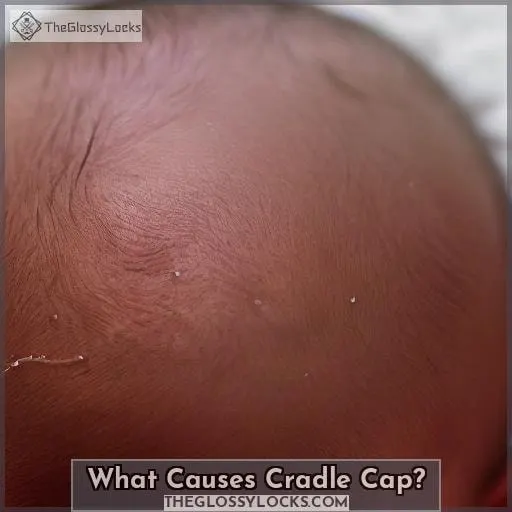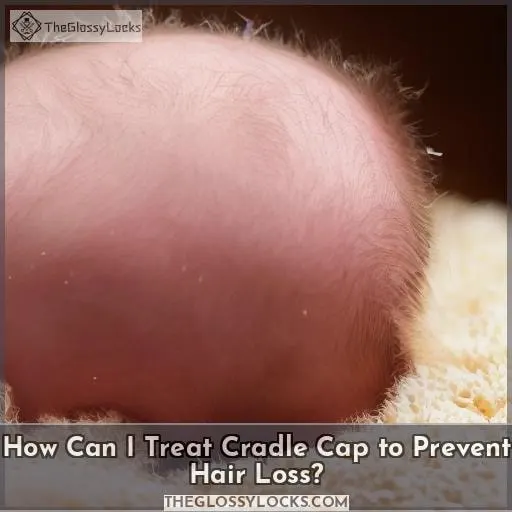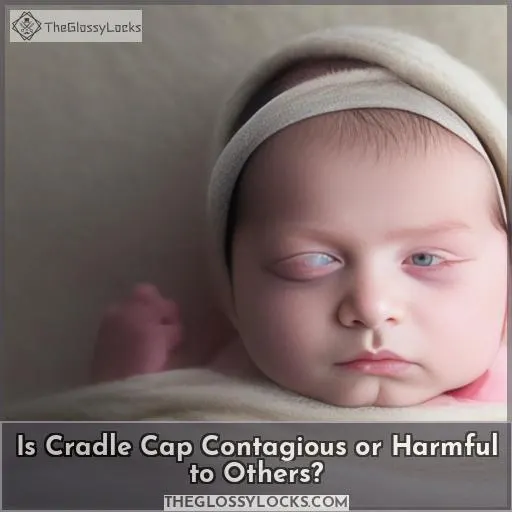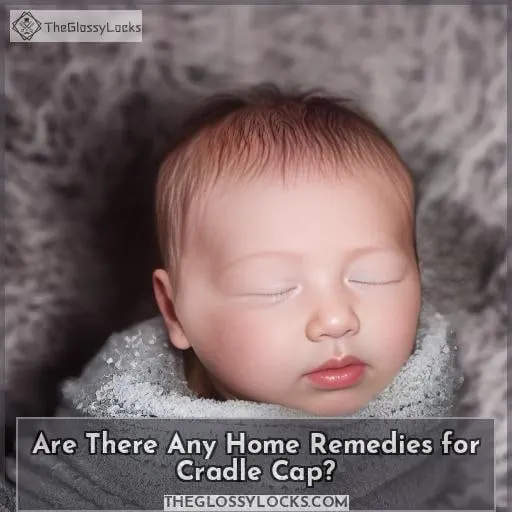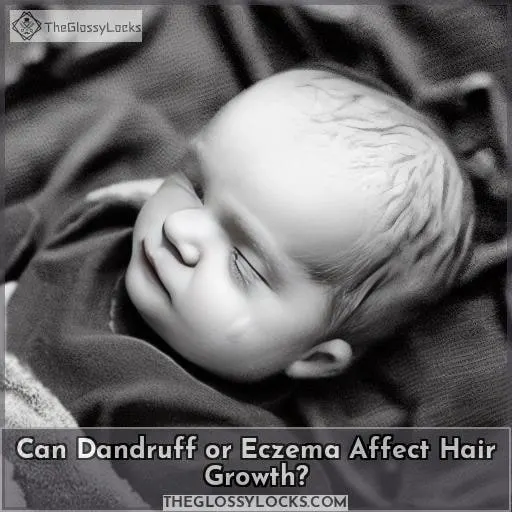This site is supported by our readers. We may earn a commission, at no cost to you, if you purchase through links.
The soft, downy hair of a newborn baby represents the promise of life and new beginnings. But for many parents, this dream is quickly replaced with distress as they discover their infant’s scalp covered in scaly patches known as cradle cap.
While it may look uncomfortable or even alarming to see your child affected by this condition, rest assured that it isn’t harmful and will not prevent hair growth from occurring normally.
Read on to learn more about how this common skin issue affects babies’ scalps and what steps you can take to ensure that your baby’s delicate tresses remain lush and full-bodied!
Table Of Contents
- Key Takeaways
- What is Cradle Cap and How Does It Affect the Scalp?
- Can Cradle Cap Cause Hair Loss?
- What Causes Cradle Cap?
- How Can I Treat Cradle Cap to Prevent Hair Loss?
- Is Cradle Cap Contagious or Harmful to Others?
- Are There Any Home Remedies for Cradle Cap?
- Can Dandruff or Eczema Affect Hair Growth?
- How Can I Promote Healthy Hair Growth in My Baby?
- When Should I Consult a Doctor About Cradle Cap and Hair Loss?
- Frequently Asked Questions (FAQs)
- Conclusion
Key Takeaways
- Cradle cap is a harmless skin condition that affects infants and does not prevent hair growth.
- It may cause temporary hair loss, but hair growth will occur normally.
- Regular cleaning sessions, basic hygiene tips, and gentle care can help prevent recurrence and promote healthy hair growth.
- Seek medical consultation if symptoms persist longer than one week after starting treatment, spread beyond the scalp, or last longer than 12 months.
What is Cradle Cap and How Does It Affect the Scalp?
Discovering scaly patches on your baby’s scalp can be alarming, but don’t worry—it’s likely just a common and harmless skin condition called cradle cap.
Cradle cap is an infant form of seborrheic dermatitis that appears as yellowish, greasy, or dry scales around the hairline. It usually shows up between two to six weeks after birth, affecting about seven out of ten babies in some way during their first year.
Fortunately, it rarely causes discomfort for your baby and doesn’t affect their general health or sleep patterns either.
The cause of cradle cap remains unknown, though it may have something to do with hormone levels from pregnancy passing through the mother into her child. Infants are more likely to get it if they have a family history related to asthma or eczema too.
As well as redness surrounding crusty brown/yellow fish scale-like patches on the scalp, there may also be temporary hair loss, which is nothing serious and unlikely permanent either. This should grow back once treated with proper hygiene practices like washing daily with mild shampoo tailored for babies’ scalps followed by gentle brushing afterwards using soft bristles suitable for newborns.
Treating cradle cap isn’t really necessary; most cases clear up within twelve months without any medical intervention needed whatsoever. But over-the-counter lotions containing hydrocortisone creams can help reduce irritation while prescription medications such as antifungals/anti Seborrheic shampoos might also assist when things persist longer than expected.
Always check in first before trying anything else yourself! To prevent recurrence, simply maintain regular routine cleaning sessions (2-3 times per week) alongside other basic hygiene tips like moisturizing frequently and keeping nails trimmed short so no unwanted scratches occur during scratching bouts (as itching sometimes occurs).
Cradle Cap isn’t contagious nor will it stop growth permanently due to its nature being benign, so you shouldn’t panic if it suddenly appears one day. Contact a doctor immediately, however, if the rash begins spreading beyond the head area, especially after the 12-month mark has been reached.
Can Cradle Cap Cause Hair Loss?
Worrying about your baby’s scalp health is common, so you may be concerned if you find out that cradle cap can cause temporary hair loss. For example, one mother reported her infant son had some bald patches on the back of his head due to mild cradle cap.
Although it’s not a serious condition, understanding what causes it and how to prevent or treat it will help keep your baby’s scalp healthy and free from harm.
Cradle Cap occurs in infants when their sebaceous glands overproduce natural oils during pregnancy due to changing hormone levels in the mother’s body. This leads to an accumulation of yellow scaly patches surrounded by a red rash on the scalp of babies between two and six weeks old.
This condition affects seven out of ten babies worldwide but tends to disappear after 12 months with no negative effects on general health or sleep patterns/feeding habits for affected children.
It’s important not to confuse Cradle Cap with Eczema, which consists mainly of red flaky skin as well as having itchiness associated with its occurrence. Cradle Cap does not have any such symptoms, nor should we connect breastfeeding or vitamin usage directly towards prevention since there are currently no studies linking them together either way positively or negatively (in regards).
Nevertheless, home remedies like washing daily using mild shampoo & brushing gently, application of petroleum jelly/mineral oil before shampooing, etc., can prove useful along with other treatments, including topical steroids/local antifungal shampoos prescribed by a physician depending upon the severity level.
To conclude, while unsightly at times, rarely uncomfortable, and easily treated, this harmless skin disorder needn’t worry parents too much, especially once they understand exactly what needs to be done!
What Causes Cradle Cap?
Although the exact cause of infant seborrheic dermatitis is unknown, it’s thought to be related to changing hormone levels in a mother’s body during pregnancy. An imbalance in these hormones can lead to an overproduction of oil in some infants’ scalp glands which can then manifest as cradle cap.
Infants are more likely to develop this harmless skin condition if they have family members with eczema or asthma, so having a family history may increase its risk factor.
Signs and symptoms include redness and flaky brown or yellow scales on the baby’s scalp that resemble fish scales, but usually don’t cause itching or discomfort for your child. It typically resolves within twelve months without any treatment at all; however, regular washing and grooming might help prevent further occurrences by keeping your baby’s scalp clean from oils and dirt buildup due to mild shampooing two to three times per week after initial resolution.
If cradle cap persists beyond 12 months old, you should contact your healthcare provider who may recommend topical steroids, local antifungals, or anti-seborrheic shampoos depending on the severity of symptoms.
It is important not to confuse infant seborrheic dermatitis (cradle cap) with eczema as there isn’t any direct correlation between them, though both present similar signs such as redness and scaly patches along with itchiness associated exclusively only with the latter condition, unlike the former one.
Cradle Cap does not involve bald spots nor will hair stop growing because it has nothing directly to do with hair follicles’ growth cycle dynamics being a completely different kind of phenomenon altogether unrelated to each other.
Cradle Cap doesn’t require special diets, vitamin supplements, etc., since no link exists between them, although breastfeeding still remains the best source of nutrition for babies, thus recommended regardless.
Finally, Cleveland Clinic emphasizes the importance of consulting a physician if something abnormal is noticed regarding appearance or health condition.
How Can I Treat Cradle Cap to Prevent Hair Loss?
Don’t let those pesky scales keep you from enjoying your baby’s beautiful locks – follow these steps to treat cradle cap and prevent hair loss!
Cradle cap, or infant seborrheic dermatitis, is a common skin condition that affects babies between two and six weeks of age. It appears as redness and crusty yellow or brown scales on the scalp that resemble fish scales.
While its exact cause is unknown, it may be related to changing hormone levels during pregnancy causing the baby’s sebaceous glands to overproduce oil.
Fortunately, there are several ways you can manage this condition so it doesn’t lead to permanent hair loss in infancy.
To start with, prevention is key: always wash your baby’s scalp daily with a mild shampoo designed for infants. Massage lather into their head using your fingers or a soft cloth, rinse thoroughly, then lightly brush their head afterwards using an extra-soft bristled brush.
This will help remove any flakes without irritating them further. If necessary, use petroleum jelly or mineral oil after washing but before brushing for added scale removal assistance.
Once initial scaling subsides, however, aim only for 2-3 shampoos per week maximum so as not to encourage another flare-up episode soon thereafter due to no longer needed frequent cleansing repetition cycles via regular weekly maintenance regimens instead going forward though!
Lastly, if symptoms persist despite doing the above, try topical steroids (as prescribed by a physician), local antifungals, anti-seborrheic shampoos, and maintain vigilance identifying/treating other areas potentially affected beyond simply just one localized spot on top region alone moving ahead here overall!
In summary, understand what causes cradle cap, get proper diagnosis by a healthcare provider, take appropriate preventive measures, apply right treatment options promptly when required, and enjoy watching all healthy new growth appear shortly thereafter down the road together now happily ever after thank goodness sure enough everyone good luck out there come rain shine same time hope content helps today much appreciate feedback given chance thanks again best regards later bye bye.
Is Cradle Cap Contagious or Harmful to Others?
No need to worry – cradle cap isn’t contagious or harmful to others. It’s a harmless skin condition that appears as yellow scaly patches surrounded by a red rash on the scalp of babies. It affects approximately 7 out of 10 infants between two and six weeks old. The exact cause of infant seborrheic dermatitis remains unknown, but research suggests that infants may be more likely to have cradle cap if they have family members with eczema or asthma due to increased activity in the baby’s sebaceous glands from changing hormone levels during pregnancy.
Cradle cap can typically be managed at home through regular washing and grooming practices. Massaging lather into your baby’s hair with your fingers or washcloth, gently brushing their hair after shampooing, using mild baby shampoos every day, and applying petroleum jelly or mineral oil before shampooing once per week all help keep scales manageable until they eventually disappear over time without any long-term effects for most babies around twelve months old.
If symptoms persist beyond this age, however, then you should consult your healthcare provider about other treatment options such as topical steroids, local antifungals, or anti-seborrheic shampoos which may offer additional relief if needed.
It’s important when addressing issues related to cradle cap causes, family history, treatment options, home care, and prevention strategies that parents understand what exactly cradle cap entails so they can take appropriate action either preventively or reactively depending on the circumstance while avoiding unnecessary stress, anxiety, potential complications resulting from bacterial infection caused by incorrect treatments administered, or another family member unknowingly transmitting the same ailment.
Patients being treated based on false assumptions or information obtained from inaccurate sources can also lead to complications.
Fortunately, modern science has given us enough insight into this condition to make educated, informed decisions regarding its management, making sure everyone stays safe, healthy, and happy!
Are There Any Home Remedies for Cradle Cap?
You can try some home remedies to help treat your baby’s cradle cap. The good news is that it doesn’t require any special medication or treatments, and most cases of cradle cap resolve on their own as long as you take the proper steps for scalp care.
Washing your baby’s hair daily with mild shampoo, massaging lather into the scalp gently with your fingers or a washcloth, and brushing softly can help remove scales from the head naturally. You may also want to apply petroleum jelly or mineral oil to loosen up stubborn patches before washing them off during baths.
Additionally, using an over-the-counter lotion specifically designed for treating infant seborrheic dermatitis at least 15 minutes prior to shampooing will provide relief by softening scaly skin cells so they shed more quickly without discomfort caused by regular rubbing on sensitive areas like babies’ scalps.
Regular grooming habits such as these should be continued even after signs of cradle cap have disappeared in order to prevent its recurrence due to its possible hormonal imbalance connection. However, if symptoms persist beyond 12 months of age, consult a healthcare provider about alternative approaches such as topical steroids, local antifungals, or anti-seborrheic shampoos which might be necessary depending upon severity and location of affected area(s).
It is important not to discount natural remedies though since normal skin cell shedding (desquamation) processes are otherwise healthy when left undisturbed while keeping in mind that extreme cases could result in temporary baldness due to unnatural removal techniques applied too vigorously.
Can Dandruff or Eczema Affect Hair Growth?
It’s important to note that while dandruff and eczema can cause discomfort, they won’t get in the way of your baby’s hair growth. Dandruff is a common condition caused by an overproduction of oils on the scalp, which leads to dryness and flaking.
Eczema is another skin condition characterized by red, itchy patches on the body or face. While both conditions may be uncomfortable for babies, they will not affect hair growth.
- Identifying triggers: It’s important to identify any potential triggers such as allergies or environmental factors that could contribute to either dandruff or eczema so you can take steps towards prevention and treatment if necessary.
- Scalp hygiene: Keeping your baby’s scalp clean with a mild shampoo helps reduce any buildup of oils from sebum glands which can lead to cradle cap or other skin irritation like dandruff and eczema.
- Dietary changes & lifestyle habits: Avoiding certain foods known as allergens could help prevent flare-ups due to diet-related sensitivities like dairy products, nuts, eggs, etc. Additionally, introducing probiotics into their diet along with regular exercise could boost their immune system, helping them fight off infections associated with these skin conditions.
- Topical treatments: Applying topical creams prescribed by healthcare professionals are used for treating symptoms until underlying causes have been addressed through dietary/lifestyle changes mentioned previously above.
- Baby’s Scalp: Gently brushing your baby’s scalp using a soft toothbrush twice daily after bath time followed up by lubricating his/her head gently rubbing mineral oil/petroleum jelly before bedtime then using a very little amount of gentle shampoo next morning rinsed properly should help keep cradle cap at bay! Breastfeeding also plays an important role in nourishing newborn babies, preventing health issues linked directly connected to developing healthy skin! A red rash, however, needs medical attention checkup just to make sure no negative effects whatsoever going to happen further down the line accompanying this issue in the long run! Ultimately, taking proper care and maintaining good hygiene go a long way in keeping away unwanted incidents involving Baby’s health, safety, and general well-being all round!!
How Can I Promote Healthy Hair Growth in My Baby?
Taking care of your baby’s scalp is important for promoting healthy hair growth. Nursing care, diet tips, and regular scalp hygiene are all key factors that can help ensure the health and beauty of your little one’s locks.
A variety of genetic factors have been identified to play a role in the development of cradle cap, but hormone balance has also been suggested as an underlying cause. The overproduction of sebum due to changing hormones in both the mother’s body during pregnancy and the baby itself after birth may contribute to this condition.
Laboratory studies suggest that when these glands become clogged or irritated, it can lead to inflammation which presents as redness on your baby’s scalp with yellow scaly patches resembling fish scales.
However, eczema is typically not associated with cradle cap even though they look similar from afar without closer examination by a healthcare provider if necessary.
When it comes to prevention, there are certain measures you should take such as washing regularly. Make sure you choose mild products specifically designed for infants like those labeled tear-free since harsh chemicals might irritate their sensitive skin further aggravating any rash already present.
Additionally, use lukewarm water no more than twice daily, soapy massage followed by thorough rinse including behind their ears and at neck area where skin folds tend accumulate sweat residue dirt throughout day.
Pat dry using a soft towel or air drying preferable afterwards, avoid rubbing vigorously scrubbing areas affected because could increase irritation worsen symptoms.
Furthermore, eating a nutritious diet rich in vitamins, minerals, essential fatty acids, and proteins is important to maintain strong nourished hairs follicles. Therefore, consult a pediatrician about supplements for nursing mothers, breastfeeding babies, or supplementing formula with particular nutrients to promote infant health growth overall well-being.
Lastly, discuss genetics family history with a doctor to see if any hereditary conditions are playing a factor. Consider having laboratory tests done to diagnose and treat properly address root problem quickly prevent recurring future problems from developing early age onwards into adulthood later life stages.
By following these steps together, we will be able to give our children the best chance of a beautiful head full of healthy hair for a lifetime to come!
When Should I Consult a Doctor About Cradle Cap and Hair Loss?
If you notice crusty, yellow patches along with hair loss on your baby’s scalp, it may be time to consult a doctor. Cradle cap is a harmless skin condition that typically doesn’t cause any serious issues but can have an impact on your child’s overall health if left untreated.
- Risk Factors: Infants are more likely to develop cradle cap if they have family members who suffer from eczema or asthma. It’s also important for parents of babies with other conditions that affect their immune system, such as HIV/AIDS or cancer, to talk with their healthcare provider about the potential risks and benefits of treating cradle cap in those cases.
- Treatment Options: Talk to your healthcare provider about treatment options, including over-the-counter lotions and shampoos specific for treating infant seborrheic dermatitis (cradle cap). Your physician may also recommend topical steroids, local antifungals, or anti-seborrheic shampoos depending on the severity of the rash and how long it has been present without improvement after home care treatments like washing daily using mild shampoo followed by massaging lather into scalp gently using fingers or washcloth then softly brushing hair afterwards.
- Hair Prevention & Baby Care: After scales disappear completely following a successful treatment regimen prescribed by a pediatrician, regular shampooing two times per week helps prevent recurrence. Additionally, applying petroleum jelly onto the affected area prior to every bath time can help soften scaly patches so they are easier to remove when combed out later during post-bath routine activity. Additionally, breastfeeding, vitamins, nor any product not approved by the FDA won’t guarantee prevention against developing this condition, although proper hygiene remains a paramount factor ensuring healthy growth development.
- Infant Health Guidelines: Seek medical consultation immediately in case symptoms persist longer than one week after starting prescription therapy, spread beyond the original location onto other body areas, last longer than the twelve-month age mark. Otherwise, these might suggest the presence of another illness unrelated directly related to the skin disorder itself, thus requiring specialized attention only professional doctors capable of providing accurate diagnosis pertaining to each individual patient’s circumstances associated therewith. Finally, always take into account the Cleveland Clinic disclaimer stating all products and services not endorsed by the entity, regardless of the fact that advertising revenue generated supports the mission. Therefore, don’t rely solely upon information obtained from this resource. Instead, seek advice from a specialist whenever you encounter uncertainty regarding infant health and well-being, as it is a matter of concern for you.
Frequently Asked Questions (FAQs)
How long does cradle cap usually last?
Cradle cap typically lasts for a few weeks to several months, but it can disappear as quickly as it arrives! With gentle care and attention, you’ll soon have your baby’s soft, healthy hair back.
Is there a difference between cradle cap and adult seborrheic dermatitis?
Yes, there is a difference between cradle cap and adult seborrheic dermatitis. Cradle cap affects the scalp of infants up to 12 months old, while ASD occurs in adults over 18 years old. Symptoms of both conditions are similar, but they may differ in other areas such as location or severity.
Are there any lifestyle changes I can make to help prevent cradle cap?
You can help prevent cradle cap by washing your baby’s scalp daily with a mild baby shampoo and massaging their hair gently.
Are there any over-the-counter treatments for cradle cap?
Yes, there are over-the-counter treatments for cradle cap. Try applying petroleum jelly or mineral oil to loosen the scales before shampooing with a mild baby shampoo and brushing gently.
Does cradle cap ever require medical treatment?
In some cases, cradle cap may require medical treatment. If the rash is not resolving or improving within one week after starting treatment, if it is affecting other areas beyond the scalp, or if it continues past 12 months of age – contact your healthcare provider.
Conclusion
In conclusion, cradle cap is a common and temporary skin condition that often affects babies. It usually disappears without treatment and rarely causes any hair loss. However, it is important to maintain regular washing and grooming to help prevent the recurrence of cradle cap.
If the condition persists beyond 12 months of age or if the rash affects other areas beyond the scalp, consult your healthcare provider.

